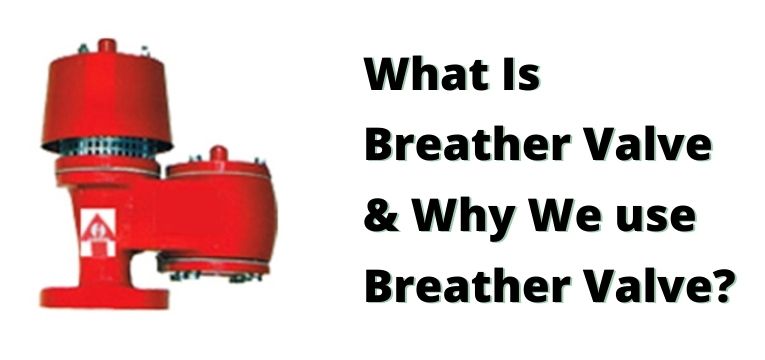What Is Breather Valve?
A breather valve is a device used to regulate pressure in a closed system. It allows air to enter or escape the system as necessary to maintain a balanced internal pressure. This helps to prevent damage to the system from overpressure or vacuum conditions. Breather valves are commonly used in storage tanks, hydraulic systems, gearboxes, and other mechanical systems.
A breather valve is a component that allows air to enter or escape from a sealed system or container, such as a storage tank or gearbox, in order to maintain a balanced internal pressure. This helps prevent overpressure or vacuum conditions which can cause damage to the system. Breather valves typically use a filter to prevent contaminants from entering the system, and may be adjustable to control the rate of airflow. They are commonly used in a variety of industrial and mechanical applications.
Why We Use Breather Valve?
Breather valves are used in closed systems to regulate pressure and prevent damage caused by overpressure or vacuum conditions. The following are some reasons why breather valves are used:
1. Maintaining Pressure Balance:
Breather valves allow air to enter or escape the system as necessary to maintain a balanced internal pressure, preventing overpressure or vacuum conditions.
2. Protecting Equipment:
Overpressure or vacuum conditions can cause damage to the system and its components, including seals, gaskets, and other mechanical parts. Breather valves help to protect equipment from damage by regulating pressure.
3. Filtering Contaminants:
Breather valves typically use a filter to prevent contaminants, such as dust, moisture, or foreign particles, from entering the system, which can cause damage or degradation.
4. Improving System Performance:
By regulating pressure and filtering contaminants, breather valves help to maintain optimal system performance and prolong equipment life.
Overall, breather valves play a crucial role in ensuring the proper functioning and longevity of closed systems and containers in various industrial and mechanical applications.
How Does A Breather Valve Work?
A breather valve works by regulating air flow into and out of a closed system or container. The valve typically consists of a housing, a filter element, and a spring-loaded valve that opens and closes based on the pressure difference between the internal and external environments.
When the internal pressure drops below atmospheric pressure, the valve opens, allowing air to enter the system. When the internal pressure rises above atmospheric pressure, the valve closes, preventing air from escaping the system. The flow rate of the valve is determined by the size of the orifice and the pressure difference between the internal and external environments.
The filter element in the valve prevents contaminants, such as dust, moisture, or foreign particles, from entering the system. This helps to maintain the integrity of the system and prevent damage or degradation.
In summary, a breather valve works by regulating air flow into and out of a closed system or container based on the pressure difference between the internal and external environments, while also filtering out contaminants that could cause damage or degradation.
Breather valve Working Principle
The working principle of a breather valve is based on the regulation of air flow into and out of a closed system or container. It allows air to enter the system when the internal pressure drops below atmospheric pressure, and allows air to escape when the internal pressure rises above atmospheric pressure. The valve’s flow rate is determined by the size of the orifice and the pressure difference between the internal and external environments.
The valve typically includes a filter element to prevent contaminants from entering the system, which can cause damage or degradation. The filter element allows air to pass through, but blocks particles and moisture that could compromise the system.
In summary, the working principle of a breather valve is to regulate the pressure in a closed system or container by allowing air to enter or escape as necessary to maintain a balanced internal pressure, while also filtering out contaminants that could cause damage.
Breather Valve Application
Breather valves are widely used in a variety of industrial and mechanical applications to regulate pressure and prevent damage caused by overpressure or vacuum conditions. Some of the common applications of breather valves include:
1. Storage Tanks:
Breather valves are used in storage tanks, such as fuel tanks or chemical storage tanks, to regulate pressure and prevent overpressure or vacuum conditions that can cause damage to the tank or its contents.
2. Hydraulic Systems:
Breather valves are used in hydraulic systems, such as those found in construction equipment, to regulate pressure and prevent damage to seals, hoses, and other components.
3. Gearboxes:
Breather valves are used in gearboxes, such as those found in automobiles and industrial machinery, to regulate pressure and prevent contamination that can cause damage to gears and bearings.
4. Compressed Air Systems:
Breather valves are used in compressed air systems, such as those found in manufacturing plants, to regulate pressure and prevent overpressure or vacuum conditions that can cause damage to the system or its components.
5. Industrial Process Equipment:
Breather valves are used in various types of industrial process equipment, such as reactors, mixers, and separators, to regulate pressure and prevent overpressure or vacuum conditions that can cause damage to the equipment or its components.
Overall, breather valves play a crucial role in ensuring the proper functioning and longevity of closed systems and containers in various industrial and mechanical applications.
Fidicon Devices is a Breather Valves manufacturer, Breather Valve with Flame Arrestor, Breather Valve Cum Flame Arrestor, and Breather Valve Pressure Vaccum Types, in Ankleshwar, Dahej, Bharuch, Gujarat, India.
